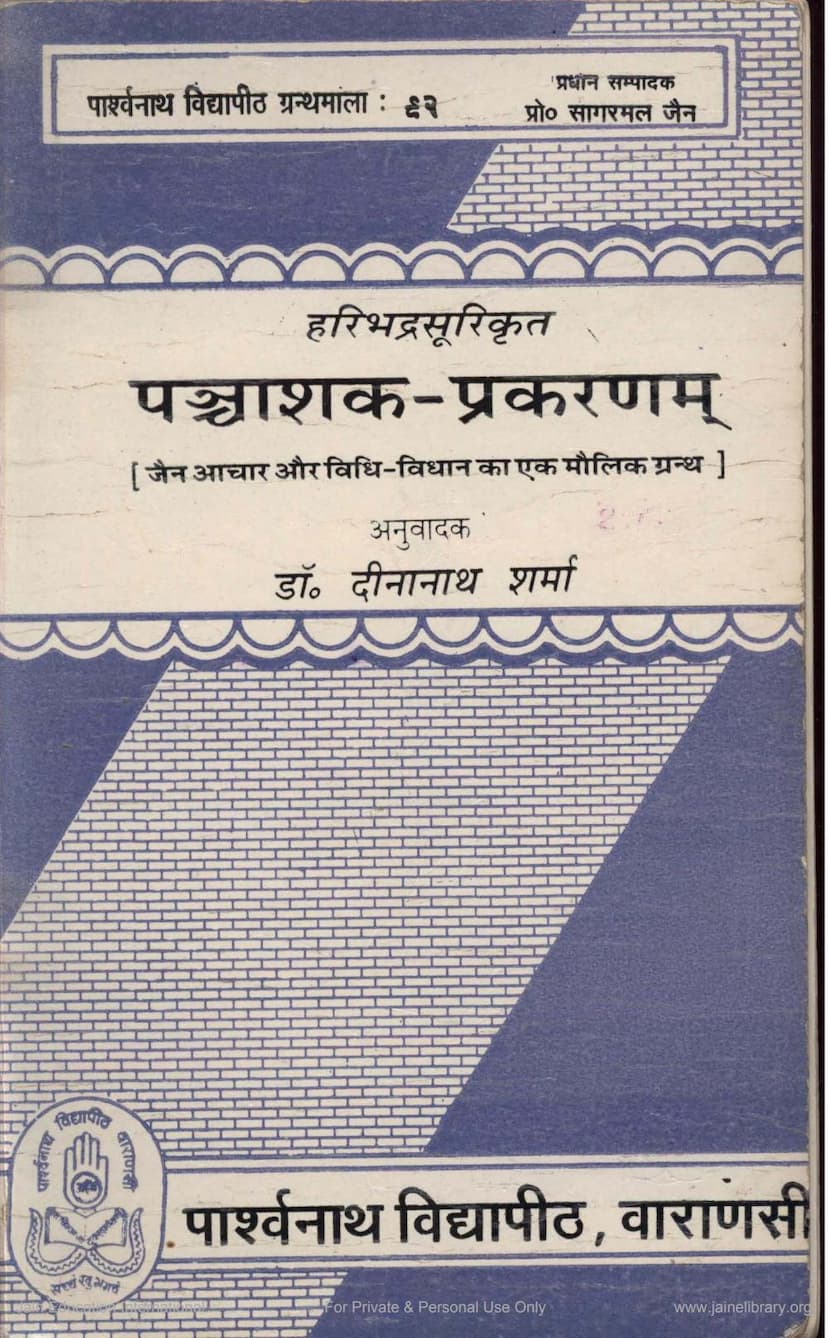Panchashak Prakaranam
Added to library: September 2, 2025

Summary
This document is a comprehensive summary and analysis of the Jain text "Panchashak Prakaranam" authored by Haribhadrasuri, with translations and editing by Dr. Dinanath Sharma, Dr. Sagarmal Jain, and Dr. Kamleshkumar Jain. Published by Parshwanath Vidyapith in Varanasi in 1997, this work is a fundamental text on Jain ethics and rituals.
Key aspects covered in the document include:
-
Author and Historical Context: It highlights the significant contribution of Acharya Haribhadra, a prominent Jain scholar of the 8th century, known for his prolific writings in both Prakrit and Sanskrit. The text emphasizes Haribhadra's philosophical acumen, his synthesis of various Indian philosophical traditions, and his role as a pioneer in Jain yoga literature and Sanskrit commentaries on Agamic texts. The context of the era, marked by intellectual debates and religious animosity, is presented to underscore Haribhadra's remarkable display of equanimity, truthfulness, generosity, and tolerance.
-
Structure and Content: "Panchashak Prakaranam" is a compilation of nineteen distinct "Panchashaks," each containing approximately fifty verses (Gathas). The text systematically elaborates on various aspects of Jain conduct and ritualistic practices, encompassing:
- Layperson's Conduct (Shravak Dharma): Detailed guidelines for householders, including the vows (Anuvratas), supporting vows (Gunavratas), and disciplinary vows (Shikshavratas).
- Asceticism (Deeksha and Sadhu Dharma): The process of initiation into monastic life and the code of conduct for ascetics.
- Rituals and Worship (Puja, Chaityavandana, Pratishtha): Procedures for idol worship, temple rituals, consecration ceremonies, and temple construction.
- Ethical Principles (Pratyakhyana, Shilaanga): The principles of renunciation, ethical disciplines, and their application.
- Other Practices: Sections on monastic daily routines, purity in alms, critique of various philosophical systems (Shad Darshana Samuccaya), yoga practices (Yoga Bindu, Yoga Vimsika, Yoga Drishti Samuccaya), and the refutation of superstitions (Dhurta Akhyan).
-
Haribhadra's Philosophical Approach: The document emphasizes Haribhadra's intellectual brilliance, characterized by his impartial presentation of diverse philosophical traditions, respectful language towards proponents of other faiths, his effort to understand the essence of concepts, and his unique ability to reconcile differing viewpoints with the Jain perspective of Anekanta (non-absolutism). His critique of superstitious beliefs, even within his own tradition, is highlighted as a testament to his revolutionary thinking.
-
Timelines and Authorship Debates: The document delves into the scholarly discussions surrounding Haribhadra's period, citing various traditions and scholarly opinions. It also acknowledges the potential attribution of some works to other Jains named Haribhadra.
-
Specific Teachings of the Panchashak: The summary provides a detailed breakdown of each of the nineteen Panchashaks, outlining the specific topics covered within each:
- Shravak Dharma Vidhi: Conduct of laypersons, including vows, duties, and daily rituals.
- Jina Deeksha Vidhi: The ceremony and process of initiation for monks and nuns.
- Chaitya Vandana Vidhi: Rituals of paying obeisance to Jina images and temples.
- Puja Vidhi: Procedures for worship and offerings.
- Pratyakhyana Vidhi: The practice of renunciation and restraint.
- Stavana Vidhi: Hymns and devotional practices.
- Jina Bhavan Nirman Vidhi: Guidelines for constructing temples.
- Jina Bimba Pratishtha Vidhi: Rituals for the consecration of Jina idols.
- Yatra Vidhi: Procedures for religious processions and pilgrimes.
- Upaasaka Pratima Vidhi: Stages of spiritual development for lay practitioners.
- Sadhu Dharma Vidhi: The conduct and duties of ascetics.
- Sadhu Samachari Vidhi: The daily conduct and etiquette for monks.
- Pinda Vidhi: Rules regarding alms and food intake for ascetics.
- Shilaanga Vidhi: Ethical disciplines and their subdivisions.
- Alochana Vidhi: The practice of confession and seeking forgiveness for transgressions.
- Prayashchitta Vidhi: Rituals of penance and atonement.
- Kalpa Vidhi: Rules concerning monastic conduct and different types of ascetic life.
- Bhikshu Pratima Kalpa Vidhi: Specific rules for ascetic practices and vows.
- Tapa Vidhi: Various forms of ascetic austerities.
-
Emphasis on Inner Purity: Throughout the text, there is a consistent emphasis on the importance of inner intention (bhava) over mere external rituals, highlighting the Jain emphasis on ethical conduct and spiritual development.
The document serves as a valuable resource for understanding the depth and breadth of Jain ethical and ritualistic traditions as codified by the influential Acharya Haribhadra.